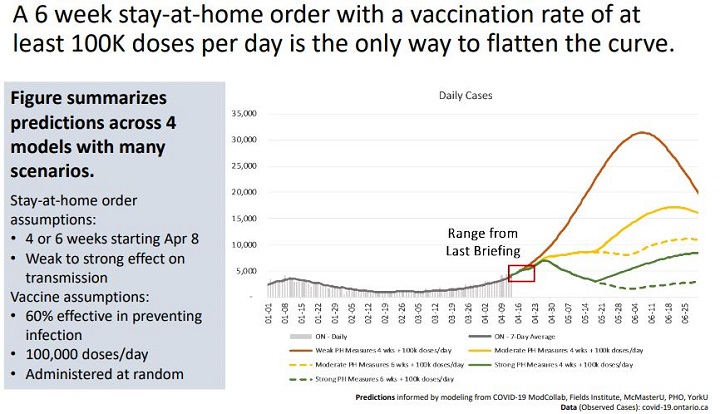Ontario health officials have released projection data indicating the only way to flatten the surge of COVID-19 cases and hospitalizations is a six-week stay-at-home order and at least 100,000 doses of vaccine administered a day.

According to the documents released Friday, there has been a 67 per cent growth in hospitalizations related to the virus and a 51 per cent growth in ICU occupancy.
Officials noted under every scenario, more vaccinations mean a faster resolution to the COVID-19 crisis in the long run.
The documents also indicated “without stronger system-level measures and immediate support for essential workers and high-risk communities, high case rates will persist through the summer.”
In terms of scenarios that were run, the red line on the graph is what daily cases would have looked like before any measures or restrictions were introduced which top at 30,000 daily cases.
The yellow line indicates the case growth with moderate measures which is what has most recently been imposed with the provincewide stay-at-home order. The solid line would be a four-week stay-at-home order and the dotted line is a six-week stay-at-home order.
The green line represents stronger public health measures, comparing it to what was seen in the first wave back in April 2020 when mobility was severely reduced. The solid line would be a four-week stay-at-home order and the dotted line is a six-week stay-at-home order.
The documents also showed that Ontarians mobility has declined slightly but is not enough to bring the current growth of infection under control.
“Further reducing mobility and always wearing a mask and distancing is how Ontarians help reduce cases,” officials wrote in the documents.
“The goal here is to flatten the curve as much as we can.”
Although variant cases, such as the B.1.1.7 first identified in the United Kingdom, now dominate and continue to rise the original COVID-19 strain is also rising, officials noted. Variant cases currently account for 70 per cent of the samples.
On Friday, Ontario reported a record-breaking 4,812 new COVID-19 cases surpassing Thursday’s previous single-day record of 4,736. In the past seven days, five of those saw daily case numbers above 4,000.
Ontario also reported a record 1,955 people are hospitalized with COVID-19 with an all-time high of 701 patients in intensive care units and 480 patients in ICUs on a ventilator.
The province’s science advisory co-chair Dr. Adalsteinn Brown, who also presented the modelling data, said ICU occupancy from the second wave never had the chance to empty out again by the time the third wave hit.
“We’re now filling up our intensive care units on top of what was still there following the second wave and this is one of the reasons that we are in such jeopardy,” Brown said.
Brown said Ontario is on track to hit almost 1,000 patients in ICUs within the next two or three weeks.
In Friday’s update, a total of 3,644,038 COVID-19 vaccine doses have been administered. That marks an increase of 115,634 vaccines in the last day which is the most vaccine administered in 24 hours. There are 341,933 people fully vaccinated with two doses.
Ontario has been administering about 100,000 vaccine doses daily. In the past week, three days were over 100,000 vaccinations in a day and the other four were just under 100,000.
The data also showed targeting vaccinations to 20 per cent of the most at-risk neighborrhoods means more cases are averted, versus going just by age.
“It actually provides a substantial improvement in control over cases compared to allocation of vaccines based on age and population size alone,” Brown said.
Dr. David Williams, Ontario’s chief medical officer of health, said based on the modelling data “there is real necessity to be worried.”
“People say why cant we be as good as we saw people doing back in March of 2020 when we had the first wave,” Williams said. “And a big difference I hear then and now is people were more concerned, worried, fearful at that time than they are now.”
Williams said daily case counts could top 5,000 by the weekend.
“There’s been a sense among the public that this pandemic is really not such a big deal,” Williams continued. “Nothing could be further from the truth.”
“Sometimes people say the measures that we have to do for strong control are more bothersome to me than the fear or concern of getting COVID. You may have felt that from the first or second wave, you should not feel that way with the third wave. You really have to take this seriously now.”








Comments